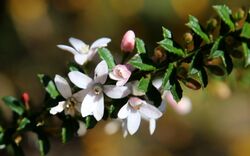Biology:Philotheca hispidula
| Philotheca hispidula | |
|---|---|

| |
| In Ku-ring-gai Chase National Park | |
| Scientific classification | |
| Kingdom: | Plantae |
| Clade: | Tracheophytes |
| Clade: | Angiosperms |
| Clade: | Eudicots |
| Clade: | Rosids |
| Order: | Sapindales |
| Family: | Rutaceae |
| Genus: | Philotheca |
| Species: | P. hispidula
|
| Binomial name | |
| Philotheca hispidula (Sieber ex Spreng.) Paul G.Wilson[1]
| |
| Synonyms[1] | |
| |
Philotheca hispidula is a flowering plant in the citrus family and is endemic to New South Wales. It is a small shrub with narrow egg-shaped to wedge-shaped leaves that are glandular-wavy on the edges, and white or pale pink flowers arranged singly in leaf axils.
Description
Philotheca hispidula is a shrub that typically grows to a height of about 1 m (3 ft 3 in) with slightly glandular-warty, finely bristly branchlets. The leaves are narrow egg-shaped to narrow wedge-shaped with the narrower end towards the base, 10–20 mm (0.39–0.79 in) long and 3–4 mm (0.12–0.16 in) wide. The flowers are usually arranged singly in leaf axils on a finely bristly peduncle 1–15 mm (0.039–0.591 in) long and a pedicel 3–5 mm (0.12–0.20 in) long. There are five semi-circular, fleshy-centred sepals about 1 mm (0.039 in) long and five broadly elliptical white or pale pink petals about 6.5 mm (0.26 in) long with a glandular keel. The ten stamens are slightly hairy. Flowering occurs in spring and the fruit is about 7 mm (0.28 in) long with a beak about 3 mm (0.12 in) long.[2][3][4]
Taxonomy
This species was first formally described in 1827 by Sprengel from an unpublished description by Franz Sieber and the description was published in Systema Vegetabilium.[5] In 2005 Paul G. Wilson changed the name to Philotheca hispidula in the journal Nuytsia.[6][7]
Distribution and habitat
Philotheca hispidula grows in forest on sandstone in the Blue Mountains and in the Sydney region.[2][3]
References
- ↑ 1.0 1.1 "Philotheca hispidula". Australian Plant Census. https://biodiversity.org.au/nsl/services/apc-format/display/162041. Retrieved 5 August 2020.
- ↑ 2.0 2.1 Wilson, Paul G.; Wilson, Annette J.G. (ed.) (2013). Flora of Australia (Volume 26). Canberra: Australian Biological Resources Study. p. 398. https://profiles.ala.org.au/opus/foa/profile/Philotheca%20hispidula. Retrieved 6 August 2020.
- ↑ 3.0 3.1 "Philotheca hispidula". PlantNET – NSW Flora Online. http://plantnet.rbgsyd.nsw.gov.au/cgi-bin/NSWfl.pl?page=nswfl&lvl=sp&name=Philotheca~hispidula.
- ↑ Les Robinson (2003). Field Guide to the Native Plants of Sydney. Kangaroo Press. p. 120. ISBN 978-0-7318-1211-0.
- ↑ "Eriostemon hispidula". APNI. https://id.biodiversity.org.au/instance/apni/498250. Retrieved 6 August 2020.
- ↑ "Philotheca hispidula". APNI. https://id.biodiversity.org.au/instance/apni/557430. Retrieved 6 August 2020.
- ↑ Wilson, Paul G. (1998). "A Taxonomic Review of the genera Eriostemon and Philotheca". Nuytsia 12 (2): 259. https://www.biodiversitylibrary.org/item/226456#page/105/mode/1up. Retrieved 6 August 2020.
Wikidata ☰ Q18075566 entry
 |

